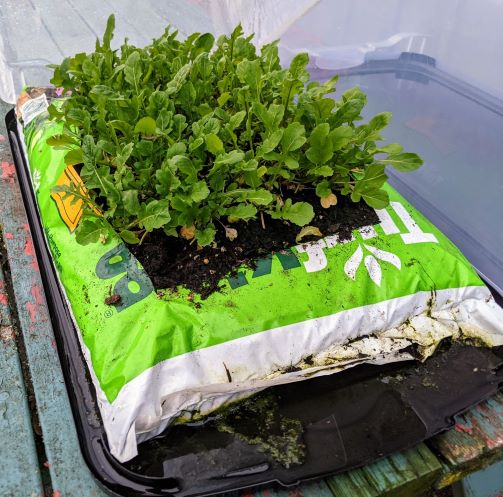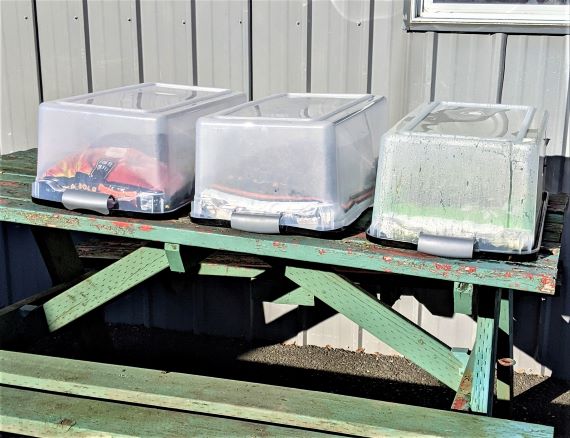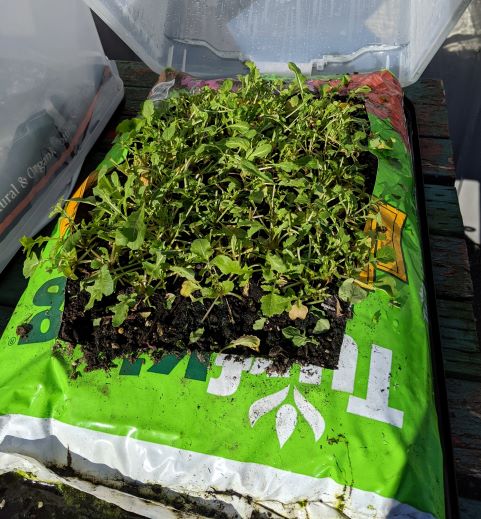Growing Food in a Small Space
Having fresh veggies is such a blessing from Mother Earth, but unless you have wilderness around you to hunt and gather, it requires a bit of work. However, for about a $10 investment, and a tiny space, you can have fresh greens on your table just about any time you want. I’m here to tell you how.
What’s your zone? First off, if you’re living in the upper reaches of Canada or Europe or certainly Alaska, this may not work for you. My growing zone here is 8a. The lowest mean average here ever is 9 degrees F, but that tends to be balanced out with getting up above freezing quickly before it dips back down (thank you wind from the Pacific Ocean). So far the lowest we have seen this year is 22 degrees F. But my baby greens mini cold frame just keeps giving me fresh veggies all fall and winter and if I keep harvesting, it will produce consistently.
What you will need: First off you need what will serve as your mini cold frame, a clear-bottomed storage container. The one I’m using was found at a local hardware store on sale (everything storage is on sale right now) for $5. I got some seeds on sale — just $2 — of some arugala (one of my favorite greens), and a bag of all-purpose potting soil. We have since expanded to include spinach and kale. Woohoo, power greens, baby! Just be advised that this is not the space to grow deep root veggies like carrots and beets and the like. Shallow things like greens, strawberries, or even lettuce would work.
Now you need to make sure the bag of soil will fit inside the inner rim of the lid. So get the measurements of your container before you purchase your bag of soil. I carry a small tape measure key chain in my purse for just such occasions.
Soil here in the Pacific Northwest can run anywhere between $3 for about 1 cubic feet (which is what you see in my photos here) to about $9 for the fancy organic stuff. For my experiment I went with the cheaper bag just to see how things went. Later on as I began to love this little gardening hack, I spent $6 on a bag(s) of soil. Since you can spend up to $6 for one harvest of greens at the market, I felt it totally worth it. You’ll also need a small watering can, but hopefully since you’re a witch, you have one of those. Grab an old pitcher, yogurt cup, whatever in the meantime if you don’t. Lastly you will need a box cutting knife. As a permaculture-focused food grower, a box cutter is part of my tool belt, since cardboard is used as weed block, path makers, etc. Box cutters with exchangeable blades run pretty inexpensively. If you don’t have a box cutter, you could use an exacto knife, or a pair of scissors you don’t mind getting a bit mucky.
Find a spot: You will want your little greenhouse to be somewhere it can get the most sun light possible, especially during the winter months. Ours are against the barn on a table on the north-end of our property, but face south. That’s prime, but honestly, when I started this, it was only getting eastern light and then a bit of south light, and it still worked. If you have questions about your particular set up and where it’s facing, etc. comment below and I’ll see if I can’t help you decide.
I have mine on top of a beat-up picnic table so I don’t have to bend to harvest; but, it can sit on the ground just fine. If you want to get it up off the ground you can use just about anything — an old filing cabinet, milk crates, heck some cinderblocks.
Put the lid where you want to keep your cold frame and put the bag of soil on it. Poke some very small holes intermittently all around the soil to allow for water drainage. You could use a screwdriver for this part if you like. Don’t make the holes too big or you’ll lose to much water.
Flip the bag of soil over and take the box knife, cutting a rectangle out of the soil bag, leaving a border of the soil bag so soil and seeds and the like don’t spill out. Now water the exposed soil and wait a bit — go have a cup of tea and take 10 minutes to be mindful. Or do a Chakra alignment exercise. You decide. Just let it sit while you focus on something else. For me, I went and pulled weeds in my herb bed. However, if you open up the bag and discover it’s super wet (which sometimes happens here in the PNW), skip the watering and just let it sit the same as if you wet it.
Once the moistened soil has sat for a bit, come back and take your finger, a trowel, the tip of your knife, your scissors, etc. and draw a serpentine pattern in the exposed soil. Be sure to pay attention to the depth suggested on the seed packet and don’t go too deep. Next you will sprinkle your greens seeds into the serpentine trough throughout the exposed rectangle. Gently push the soil over the seeds and do another light soaking of the soil. Put your cover on and wait. Now it’s time to talk to your seeds. Tell your baby greens how excited you are to meet them and that you will always take care of them. Or tell them whatever you prefer.
Be sure to check daily for soil moisture in these first couple of days. Seeds need a good bit of water to make sure they germinate. The moisture from the enclosed heat will help keep them moist, but be sure to check. Don’t forget. Add water as needed. Do not make mud. Just so that it’s moist to the touch.
Once the greens take shape, you may find you need to thin. Don’t thin too much as the you are harvesting these before they get to big and the plants close together help keep themselves warm. Once the shoots lose that little heart shaped baby leaves and have about a 1 to 3-inch regular leaf you can harvest. You are welcome to harvest the microgreens, too (those heart shaped leaves I was talking about), I just prefer the stronger flavor of the bigger ones. Snip with scissors and rinse and eat! Be sure not to pull the roots. You want your greens to keep growing. Add to your morning eggs, on your lunch sandwiches, or your green smoothies. So many options!
One word of note, I recommend you turn the frame around so that the north side of it — however you have it oriented, gets flipped at each harvesting. Mine is oriented north to south, so I bring the north end to south at each harvest. That way the natural moss that will likely grow on the north end, doesn’t really have time to take shape.
Weekly check for water needs. The more you harvest, the more it will grow. Each frame for me gives me about two meals for the two of us each week. And I’m not stuck with plastic bags or containers from the market. So good for me and my planet. We started this cold frame back in Late October. From the first week of November, onward I’ve had a harvest of fresh greens at least once a week. That initial $10 investment has paid itself over nearly four times. I’ll take it! And all I have to do is walk out my back door, snip, rinse, eat!
If you wanted to grow a variety in one frame, you could do that, too. Just use 1/3 a packet of seeds per 3 varieties.
Knowing and growing your own food is so satisfying, I’d like to inspire everyone to do what they can no matter what kind of space they have. An apartment balcony? You can do this. A small city lot? You can do this. A condo with a small patio? You can do this. And on and on. You don’t have to be a declared “green witch” to have fresh greens right from your own sacred space.
Again, if you have questions, feel free to comment below and we’ll get you going on growing your own food. If you do undertake this quick and easy baby greens mini cold frame, let me know below how it works out.
Until next time, be your truest self and live your best life.
~Runa



Can’t wait to try this!
Yay! Let me know how it goes, please!
Oh to work from my bath! Lol disastrous surely with my cards and computer but I stand by the hope! Love all these tips and definitely make sure my tools are also cleared regularly and pack my bra with stones! ❤️❤️
via GIPHY
” rel=”noopener” target=”_blank”>You know it!